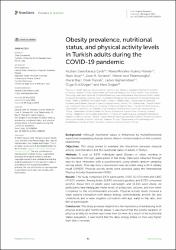| dc.contributor.author | Çelik, Kezban Esen Karaca | |
| dc.contributor.author | Morales-Suarez-Varela, Maria | |
| dc.contributor.author | Uçar, Nazlı | |
| dc.contributor.author | Soriano, Jose M. | |
| dc.contributor.author | Palamutoğlu, Merve İnce | |
| dc.contributor.author | Baş, Murat | |
| dc.contributor.author | Toprak, Dilek | |
| dc.contributor.author | Hajhamidiasl, Ladan | |
| dc.contributor.author | Doğan, Özge Erol | |
| dc.contributor.author | Doğan, Mert | |
| dc.date.accessioned | 2024-12-02T07:40:19Z | |
| dc.date.available | 2024-12-02T07:40:19Z | |
| dc.date.issued | 2024 | en_US |
| dc.identifier.citation | Karaca Çelik, K. E., Morales-Suárez-Varela, M., Uçar, N., Soriano, J. M., İnce Palamutoğlu, M., Baş, M., Toprak, D., Hajhamidiasl, L., Erol Doğan, Ö., & Doğan, M. (2024). Obesity prevalence, nutritional status, and physical activity levels in Turkish adults during the COVID-19 pandemic. Frontiers in Nutrition, 11. https://doi.org/10.3389/fnut.2024.1438054 | en_US |
| dc.identifier.issn | 2296-861X | |
| dc.identifier.uri | https://hdl.handle.net/20.500.12900/471 | |
| dc.description.abstract | Background Although nutritional status is influenced by multidimensional aspects encompassing physical factors, there is limited research on this complex relationship.Objectives This study aimed to examine the interaction between physical activity level indicators and the nutritional status of adults in T & uuml;rkiye.Methods A total of 3,970 individuals aged 18 years or older, residing in Afyonkarahisar (T & uuml;rkiye), participated in this study. Data were obtained through face-to-face interviews with a questionnaire, using simple random sampling among adults. One-day food consumption was recorded using a 24-h dietary recall (24HDR). Physical activity levels were assessed using the International Physical Activity Questionnaire (IPAQ).Results This study comprised 3,970 participants: 2,087 (52.57%) men and 1,883 (47.42%) women. Among them, 32.64% smoked cigarettes, and 8.72% consumed alcohol. About 40% of adults were overweight, and 16.33% were obese. All participants had inadequate intake levels of potassium, calcium, and iron when compared to the recommended amounts. Physical activity levels showed a weak positive correlation with dietary energy, carbohydrates, protein, fat, and cholesterol, and a weak negative correlation with age, waist-to-hip ratio, and BMI of participants.Conclusion This study provides insights into the importance of addressing both physical activity and nutritional status. It was found that the weekly duration of physical activity for women was lower than for men. As a result of the nutritional status evaluation, it was found that the daily energy intake of men was higher than that of women. | en_US |
| dc.language.iso | eng | en_US |
| dc.publisher | FRONTIERS MEDIA SA | en_US |
| dc.relation.isversionof | 10.3389/fnut.2024.1438054 | en_US |
| dc.rights | info:eu-repo/semantics/openAccess | en_US |
| dc.subject | Obesity | en_US |
| dc.subject | Physical activity | en_US |
| dc.subject | International physical activity questionnaire | en_US |
| dc.subject | Nutritional status | en_US |
| dc.title | Obesity prevalence, nutritional status, and physical activity levels in Turkish adults during the COVID-19 pandemic | en_US |
| dc.type | article | en_US |
| dc.department | İstanbul Atlas Üniversitesi, Tıp Fakültesi, Dahili Tıp Bilimleri Bölümü | en_US |
| dc.contributor.institutionauthor | Toprak, Dilek | |
| dc.identifier.volume | 11 | en_US |
| dc.relation.journal | FRONTIERS IN NUTRITION | en_US |
| dc.relation.publicationcategory | Makale - Uluslararası Hakemli Dergi - Kurum Öğretim Elemanı | en_US |

















